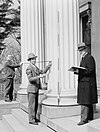File:PERSPECTIVE VIEW OF SOUTH FRONT AND EAST SIDE, LOOKING NORTH; FROM ACROSS WYOMING AVENUE TO SHOW BUILDING IN CONTEXT - Free Library of Philadelphia, Wyoming Branch, 231 East Wyoming HABS PA-6766-1.tif

Original file (5,131 × 4,155 pixels, file size: 40.69 MB, MIME type: image/tiff)
Captions
Captions
Summary
[edit]| PERSPECTIVE VIEW OF SOUTH FRONT AND EAST SIDE, LOOKING NORTH; FROM ACROSS WYOMING AVENUE TO SHOW BUILDING IN CONTEXT - Free Library of Philadelphia, Wyoming Branch, 231 East Wyoming Avenue, Philadelphia, Philadelphia County, PA | |||||
|---|---|---|---|---|---|
| Photographer |
Elliott, Joseph E., creator |
||||
| Title |
PERSPECTIVE VIEW OF SOUTH FRONT AND EAST SIDE, LOOKING NORTH; FROM ACROSS WYOMING AVENUE TO SHOW BUILDING IN CONTEXT - Free Library of Philadelphia, Wyoming Branch, 231 East Wyoming Avenue, Philadelphia, Philadelphia County, PA |
||||
| Description |
Carnegie, Andrew; Johnson, Philip H., architect; Preservation Alliance of Greater Philadelphia, sponsor |
||||
| Depicted place | Pennsylvania; Philadelphia County; Philadelphia | ||||
| Date | 2007 | ||||
| Dimensions | 4 x 5 in. | ||||
| Current location |
Library of Congress Prints and Photographs Division Washington, D.C. 20540 USA http://hdl.loc.gov/loc.pnp/pp.print |
||||
| Accession number |
HABS PA-6766-1 |
||||
| Credit line |
|
||||
| Notes |
Philadelphia was the recipient of one of the largest Carnegie grants for library construction. Although the city was among the first to establish a free library system, it had no purpose-built structures prior to the Carnegie endowment. The branch libraries were built between 1905 and 1930, under the direction of the city appointed Carnegie Fund Committee, and designed by a "who's-who" of Philadelphia's architects. The twenty extant branch libraries remain as a remarkable intact and cohesive grouping, rivaled only by that of New York City, with fifty-seven. The Wyoming Branch was designed by architect for the city, Philip H. Johnson. He was one of only two architects to design more than one of Philadelphia's Carnegie branch libraries; Johnson was also responsible for the design of the Greenwich (no longer extant) and Kingsessing libraries. The land was set aside from a portion of a city playground, the remainder of which is still used for public recreation and is located to the rear of the building. From an architectural standpoint the Wyoming Branch is typical of Philadelphia's Carnegie-funded branch libraries; it follows the almost formulaic understated Beaux Arts styling, T-plan, and brick construction that came to define Carnegie Libraries nationwide. In addition, this building was touted as completely fireproof throughout, constructed with a steel substructure, faced with brick, and including limestone detail elements. It also bears the distinction of being the last Carnegie-funded library built anywhere.
|
||||
| Source | https://www.loc.gov/pictures/item/pa4084.photos.574007p | ||||
| Permission (Reusing this file) |
|
||||
File history
Click on a date/time to view the file as it appeared at that time.
| Date/Time | Thumbnail | Dimensions | User | Comment | |
|---|---|---|---|---|---|
| current | 09:23, 1 August 2014 |  | 5,131 × 4,155 (40.69 MB) | Fæ (talk | contribs) | GWToolset: Creating mediafile for Fæ. HABS 31 July 2014 (3000:3200) |
You cannot overwrite this file.
File usage on Commons
The following page uses this file:
Metadata
This file contains additional information such as Exif metadata which may have been added by the digital camera, scanner, or software program used to create or digitize it. If the file has been modified from its original state, some details such as the timestamp may not fully reflect those of the original file. The timestamp is only as accurate as the clock in the camera, and it may be completely wrong.
| Width | 5,131 px |
|---|---|
| Height | 4,155 px |
| Compression scheme | Uncompressed |
| Pixel composition | Black and white (Black is 0) |
| Image data location | 24,962 |
| Orientation | Normal |
| Number of components | 1 |
| Number of rows per strip | 4,155 |
| Bytes per compressed strip | 42,638,610 |
| Horizontal resolution | 1,000 dpi |
| Vertical resolution | 1,000 dpi |
| Software used | Adobe Photoshop CS4 Macintosh |
| File change date and time | 09:06, 30 April 2013 |
| Color space | Uncalibrated |
| warning | wrong data type 7 for "RichTIFFIPTC"; tag ignored. |

